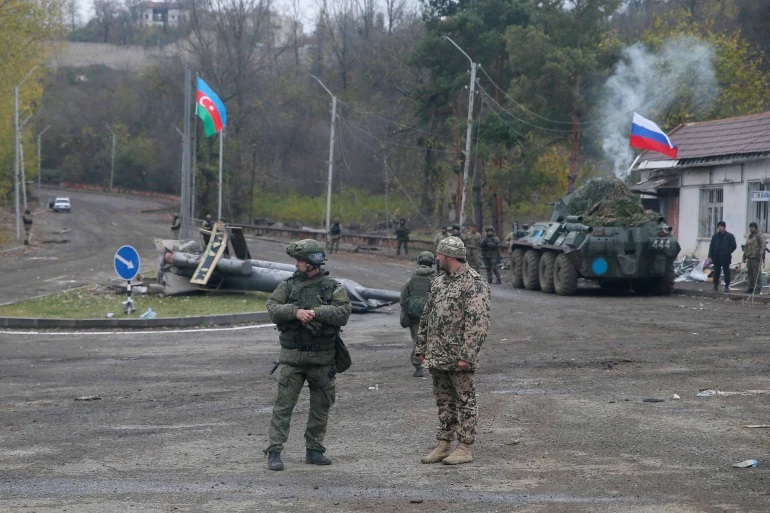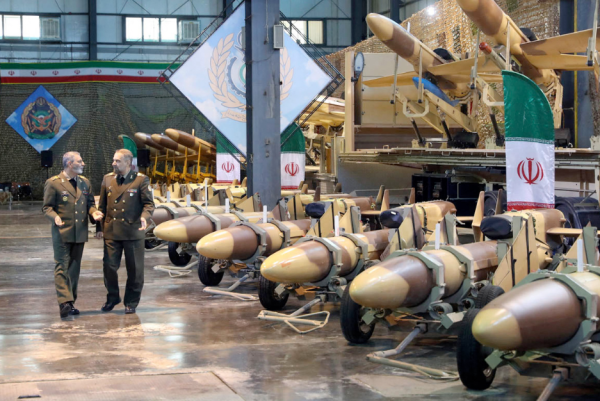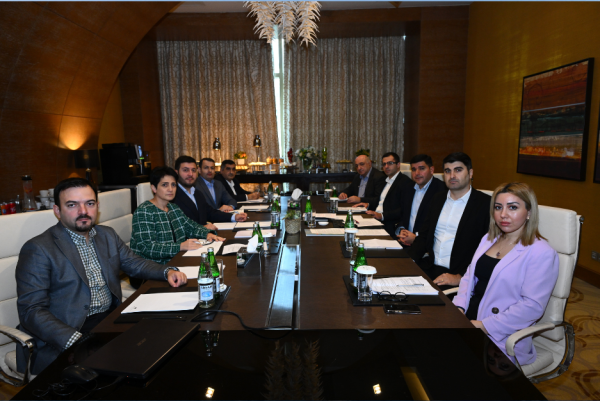Economic impact of peacekeeping forces and the case of Karabakh

Photo: An Azerbaijani service member and a Russian peacekeeper stand guard at a checkpoint on the outskirts of Şuşa (Shusha) in Nagorno-Karabakh on 13 November 13, 2020. Reuters
The peacekeeping operations are deployed to restore peace and security in the areas, and with this create a stable and secure environment for the development. Their essential purpose is to prevent the escalation of the conflicts, and eliminate the existing ones ensuring the restoration of peace. Yet, what is overlooked in the discussion of peacekeeping forces in their impact on the local economy. Whether these economic impacts are positive or negative in the end essentially depends on many aspects of the operation ranging from its duration, character, to which peacekeepers the discussion is going around (UN, NATO, EU or third countries) and also the local dynamics (being the area’s level of economic development, the post-conflict situation, and even the local population’s willingness to accept help).
On 10 November the Second Karabakh War came to an end with the signing of the tripartite agreement by Azerbaijan, Russia and Armenia. As a part of the agreement, 1960 Russian peacekeeping forces were deployed to the Karabakh region. Twenty-three posts in total has been set up and the area has been divided into two zones of responsibility for the peacekeepers (see map). In the Northern zone 11 observation posts were set by the 1st Battalion of the 15th Motorised Rifle Brigade, yet in the southern 12 observation posts were installed by 2nd Battalion [1]. The command post center has been established in the city of Xankəndi (Khankendi) from where the operations are controlled. Hence, the question is how (if so) the deployed mission might change the local economic situation.
It is important to note that, in global experience the peacekeeping mission budget’s local impact is generally less than 10% of its total budget, yet this still presents a big contribution towards the local economies in some cases. Indeed, the effect of the contribution does not need to be always direct, as the money spent by the mission personnel is re-spent by the recipients creating a fiscal stimulus cycle. Calling this the estimate “Keynesian multiplier” it is assumed that for each $1 of mission spending, $1.50 is generated [2].
In international experience particularly the peacekeeping missions of the UN have been both praised to help jump-start the local economy in the early recovery process providing employment and injecting money into the areas, and criticized for inflationary effects of their operations. To roughly put the economic effect of the peacekeeping mission can come from three areas:
1. Consumption of the personnel
2. Local acquisition of goods and services
3. Local job markets
Consumption of the personnel
The reports have revealed that the largest spending in the UN’s peacekeeping missions (around 40% of the total spending) goes to housing, followed by food and recreation. Particularly, it is typical in the UN missions for the personnel to arrange their accommodation on real-estate markets which leads to the skyrocketing rent prices and results in the renovation of the houses to meet the norms and standards and to be rented at the highest possible price. An example to this can be the UN mission to Kosovo which over the period of 2000-2002 resulted in a double and triple spike in house prices [3] (yet dropping with the reduction of mission personnel). The consumption of the catering service follows the accommodation sphere bringing money to the area. Expenditures in these areas develop the restaurants or catering businesses where more employment and profit is generated, and entrepreneurship is incentivised. Nevertheless, spendings on both the accommodation and leisure field (including those on restaurants, hotels and other purchases) have the risk of creating a boom-bust cycle, with the possibility of these businesses to collapse or bounce back to unsustainable sales with the end of the missions.
Local acquisitions of goods and services
Local procurement is the second largest component of the peacekeeping mission spending. “Outsourcing” of local services includes washing, cleaning, transport, communication services or fuel and stationery supplies, even fresh local food or purchasing materials for constructing their bases do inject direct money to the economy. All in all, the peacekeeping missions undertake actions that require similar needs ranging from consumables (oil, paper, water) or transportation and communication facilities. In some instances, where economies do not have a diversified structure (example can be Timor Leste or Liberia), the goods and services required by the mission are not available immediately locally, or the area does not have the capacity to initiate their supplies. While in these cases the foreign companies are procured, for better value for money, locally produced goods are known to be preferred by the missions as it is a faster and cheaper way. Yet, the scale of the local acquisitions mainly depends on the factors like location of the forces, duration of the mission and to what extent the refugees or displaced people have returned to the areas.
Impact on job market
Last but not least, peacekeeping missions also hire national staff which can undertake administrative, clerical support roles with a low pay rate. National staff hiring by the peacekeeping missions have both a direct and indirect impact on the local economies concerned. Most missions rely on outsourcing contracts for labour intensive functions, which are less qualified in nature and are limited in number. Yet in peacekeeping missions employing locals serve two objectives: first is obviously from purely economic dimension it injects the needed financial resources to the economy, yet secondly, it also might increase the credibility and even justify the presence of the mission in the area [4]. In some cases, employing locals also helps to train them (as particularly in UN missions English language, computing and administrative skills training are offered) and paid wages get spent on the locally produced goods sustaining the economic cycle. Yet, the missions’ big budgets sometimes cause disproportionate salary bidding, to the extent of even pushing the qualified employees from local businesses to work for multinational forces, in positions that they are overqualified for.
In all, while these kinds of operations naturally bring money into the local areas in many instances the peacekeeping mission expenditures cause excess inflation, and even create parallel economies which work to satisfy the needs of the missions.
Case of Karabakh
Returning to the case of Karabakh, what can one expect economically from the missions’ spendings? As the deployment of the Russian peacekeeping forces to Karabakh was finalized on November 21, the Kremlin announced that it would be paying for the peacekeeping mission’s expenditures and salaries, and guaranteed compensations to the families of the personnel [5]. Yet, the amount of mission budget and the salaries are still not known, as there has not been an official comment on this. Nevertheless, Putin in his live speech on Russia 24 noted that the personnel in Nagorno-Karabakh are going to get the additional paychecks for their peacekeeping work, besides their military salaries [6]. Also, South Caucasus expert Yury Sigov in his article claims that the peacekeeping mission to Karabakh will allegedly cost about $35 to 50 million per year to Russia (in case no fighting flares up) [7]. Moreover, military expert Viktor Latovkin assumes that the salaries of the Karabakh-based peacekeeping personnel will vary around 150,000 russian rubles ($2071, although obviously the amount is determined by rank [8]). Indeed, assuming that around 10% of the total one-year spending will have a local economic impact, then one might theoretically expect around $3-5 million worth of impact of the peacekeeping mission spending. Yet does such calculation hold true in the case of Karabakh? Not really… First of all, considering the fact that accommodation is one of the main sources of injecting money to the local economy, in the case of Karabakh this sector might not flourish at all. This is because, in December it was announced that a block-modular camp accommodating 250 personnel of Russian peacekeeping contingent in Xankəndi (Khankendi) was opened, furnished with modern facilities [9]. Moreover, Russian Defense Minister Sergei Shoigu noted that further 32 townships would be built until April 1, 2021 [10], meaning that technically the mission personnel will not need to rent local houses. Yet, still the alleged salaries of the mission personnel are way higher than the regional averages. In Azerbaijan, average monthly salary is considered to be 710 manats (around $417) [11] in Armenia it is around $350-370 [12]. Particularly with even lower salaries in the region, then the peacekeeper’s mission spending might create an economy which will operate to mainly serve their needs. However, what is important to note is that any benefits that might come from the money injected by peacekeepers (in forms of spendings on restaurants, consumer goods or hiring staff) will firstly benefit the Armenian-populated cities, as it will take time for Azerbaijani IDPs to return back to their lands, start the economy and offer various services. Thus, one might say that the peacekeeping mission’s expenditure will boost the local economy in Karabakh, but the local procurement practice, and the ways in which the personnel will go about hiring and paying locals will determine the extent of it.
References
[1] President of Russia. 2020. “Meeting on Russian peacekeeping mission in Nagorno-Karabakh” Available at: http://en.kremlin.ru/events/president/news/64455
[2] Raszka, V. and Krč, M., 2013. Economic Impacts Of Peacekeeping Operations On Local Economy (Host Nation). University Of Defence/Czech Republic, 61.
[3] Carnahan, M., Durch, W.J. and Gilmore, S., 2006. Economic impact of peacekeeping. United Nations, Peacekeeping Best Practices Unit.
[4] Raszka, V. and Krč, M., 2013. Economic Impacts Of Peacekeeping Operations On Local Economy (Host Nation). University Of Defence/Czech Republic, 61.
[5] Akperov 2020. “Правительство РФ будет финансировать дислоцированных в Нагорном Карабахе российских миротворцев”. Apa.az Available at: https://apa.az/ru/nagornyj_karabakh/Pravitelstvo-RF-budet-finansirovat-dislocirovannyh-v-Nagornom-Karabahe-rossijskih-mirotvorcev-429042
[6] News.ru 2020. “Российские миротворцы в Карабахе получат дополнительные выплаты” Available at:
https://news.ru/cis/rossijskie-mirotvorcy-v-karabahe-poluchat-dopolnitelnye-vyplaty/
[7] Сигов 2020. “Кто оплатит миротворческую операцию в Карабахе”. Ng.ru Available at:https://www.ng.ru/kartblansh/2020-11-17/3_8016_kartblansh.html
[8] Aif.ru “Сколько получают миротворцы?”. Available at: https://aif.ru/society/army/skolko_poluchayut_mirotvorcy
[9] Ministry of Defence of Russian Federation 2020. “In Stepanakert, a block-modular camp was installed for Russian peacekeepers”.Available at: http://eng.mil.ru/en/russian_peacekeeping_forces/news/more.htm?id=12331116@egNews
[10] Azerfocus 2020. “Sergei Shoigu: Russian Peacekeepers to Establish 33 Mobile Towns in Karabakh”. Available at: https://azerfocus.com/sergei-shoigu-russian-peacekeepers-to-establish-33-mobile-towns-in-karabakh
[11] Abc.az “Average monthly nominal salary in Azerbaijan”. Available at: http://abc.az/en/news/58174
[12] Stotz 2020. “Average and Minimum Salary in Yerevan, Armenia”.Checkin Price. Available at:
https://checkinprice.com/average-and-minimum-salary-in-yerevan-armenia/







